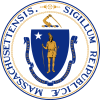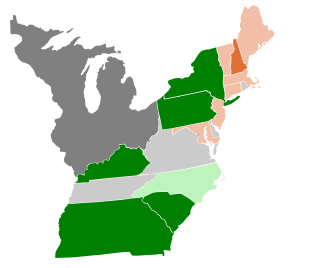| Elections in Massachusetts |
|---|
 |
Of the 14 Massachusetts incumbents, only half were re-elected.
Massachusetts law required a majority for election, which was not met in the 1st and 6th districts, necessitating a second trial that carried over until 1801.
| District | Incumbent | This race | |||
|---|---|---|---|---|---|
| Representative | Party | First elected | Results | Candidates | |
| Massachusetts 1 "1st Western district" | Theodore Sedgwick | Federalist | 1798 | Incumbent retired. New member elected. Democratic-Republican gain. | First ballot (November 3, 1800): John Bacon (Democratic-Republican) 49.3% Ephraim Williams (Federalist) 49.1% Scattering 1.6% Second ballot (March 9, 1801): √ John Bacon (Democratic-Republican) 59.0% Ephraim Williams (Federalist) 41.0% |
| Massachusetts 2 "2nd Western district" | William Shepard | Federalist | 1796 | Incumbent re-elected. | √ William Shepard (Federalist) 73.4% William Lyman 12.9% Scattiner 13.8% |
| Massachusetts 3 "3rd Western district" | Samuel Lyman | Federalist | 1794 | Incumbent retired. New member elected. Federalist hold. Incumbent then resigned November 6, 1800 and the winner then elected to finish the term, see above. | √ Ebenezer Mattoon (Federalist) 75.9% Thomas Dwight (Democratic-Republican) 14.6% Daniel Bigelow 4.9% Scattering 4.6% |
| Massachusetts 4 "4th Western district" | Dwight Foster | Federalist | 1793 | Incumbent resigned June 6, 1800 when elected U.S. Senator. New member elected. Democratic-Republican gain. Winner also elected to finish the term, see above. | √ Levi Lincoln Sr. (Democratic-Republican) 52.8% Jabez Upham 41.5% Salem Towne (Federalist) 3.8% Seth Hastings (Federalist) 1.9% |
| Massachusetts 5 "1st Southern district" | Lemuel Williams | Federalist | 1798 | Incumbent re-elected. | √ Lemuel Williams (Federalist) 61.9% Isaiah L. Green (Democratic-Republican) 26.6% Isaiah Coffin (Democratic-Republican) 11.5% |
| Massachusetts 6 "2nd Southern district" | John Reed Sr. | Federalist | 1794 | Incumbent retired. New member elected. Democratic-Republican gain. | First ballot (November 3, 1800): Nahum Mitchell (Federalist) 36.2% Josiah Smith (Democratic-Republican) 32.7% Samuel Niles (Democratic-Republican) 8.9% Benjamin Whiteman (Federalist) 6.9% Nathaniel Goodwin (Federalist) 5.9% Daniel Snow (Democratic-Republican) 3.6% Scattering 5.9% Second ballot (March 9, 1801): √ Josiah Smith (Democratic-Republican) 50.7% Nahum Mitchell (Federalist) 45.4% Samuel Niles (Democratic-Republican) 3.9% |
| Massachusetts 7 "3rd Southern district" | Phanuel Bishop | Democratic-Republican | 1798 | Incumbent re-elected. | √ Phanuel Bishop (Democratic-Republican) 57.6% Elisha May (Federalist) 25.7% Stephen Bullock (Democratic-Republican) 9.9% Laban Wheaton (Federalist) 6.9% |
| Massachusetts 8 "1st Middle district" | Harrison Gray Otis | Federalist | 1796 | Incumbent retired. New member elected. Democratic-Republican gain. | √ William Eustis (Democratic-Republican) 52.9% Josiah Quincy (Federalist) 47.1% |
| Massachusetts 9 "2nd Middle district" | Joseph Bradley Varnum | Democratic-Republican | 1794 | Incumbent re-elected. | √ Joseph Bradley Varnum (Democratic-Republican) 71.8% Timothy Bigelow (Federalist) 27.2% Others 1.0% |
| Massachusetts 10 "3rd Middle district" | Samuel Sewall | Federalist | 1796 (Special) | Incumbent resigned January 10, 1800 to become Justice of the Massachusetts Supreme Judicial Court. New member elected. Federalist hold. Winner also elected to finish the term, see above. | √ Nathan Read (Federalist) 55.0% Jacob Crowninshield (Democratic-Republican) 44.0% |
| Massachusetts 11 "4th Middle district" | Bailey Bartlett | Federalist | 1797 (Special) | Incumbent retired. New member elected. Federalist hold. | √ Manasseh Cutler (Federalist) 75.5% Thomas Kitteridge (Democratic-Republican) 21.4% Others 3.1% |
| Massachusetts 12 "1st Eastern district" (District of Maine) | Silas Lee | Federalist | 1798 | Incumbent re-elected. | √ Silas Lee (Federalist) 50.8% Henry Dearborn (Democratic-Republican) 45.6% Scattering 3.6% |
| Massachusetts 13 "2nd Eastern district" (District of Maine) | Peleg Wadsworth | Federalist | 1792 | Incumbent re-elected. | √ Peleg Wadsworth (Federalist) 76.8% John Chandler (Democratic-Republican) 14.1% Stephen Longfellow (Federalist) Scattering 4.7% |
| Massachusetts 14 "3rd Eastern district" (District of Maine) | George Thatcher | Federalist | 1788 | Incumbent re-elected. Winner later declined to serve and a special election would be held to fill the vacancy. | √ George Thatcher (Federalist) 61.8% Richard Cutts (Democratic-Republican) 38.2% |











